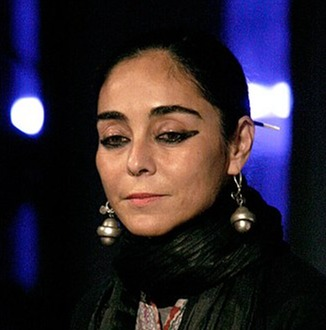
Shirin Neshat
Shirin Neshat, an Iranian-born artist of global acclaim, has made profound contributions to the world of contemporary art with a focus on photography, film, and video installations. Her work delves into the intersections of Islam and Western culture, femininity and masculinity, the distinctions between public and private life, and the contrasts between antiquity and modernity.
Biography of Shirin Neshat
Born in 1957 in Qazvin, Iran, Shirin Neshat currently resides and creates in New York City, USA. She holds a position as a critic in the photography department at the Yale School of Art.
Neshat's journey into the art world was shaped by a diverse set of experiences. She spent part of her education in a Catholic boarding school in Tehran and subsequently left Iran in 1975 to pursue her passion for art at the University of California, Berkeley. There, she earned her BA, MA, and MFA degrees, studying under the mentorship of esteemed artists Harold Paris and Sylvia Lark.
Upon completing her studies at UC Berkeley in 1983, Neshat relocated to New York City. Her life took a pivotal turn when she met her future husband, who managed the Storefront for Art and Architecture, an alternative art space in Manhattan. She dedicated a decade of her life to working alongside him in this creative environment.
In 1990, Shirin Neshat returned to Iran, where her artistic exploration took a profound and introspective turn. She began photographing herself in the chador, a traditional Islamic veil worn by women. This period was marked by the requirement, under Islamic law, for women to wear the chador. Neshat's art delved deep into the physical, emotional, and cultural connotations of veiled women in Iran, offering a unique and powerful perspective on this complex issue.
From 2000 onwards, Neshat expanded her artistic horizons to include film, participating in various renowned film festivals such as the Telluride Film Festival, Chicago International Film Festival, San Francisco International Film Festival, Locarno International Film Festival, Tribeca Film Festival, Sundance Film Festival, and the Cannes Film Festival.
In July 2009, Shirin Neshat joined a three-day hunger strike at the United Nations Headquarters in New York to protest the controversial 2009 Iranian presidential election.
In 2022, Neshat's art took a powerful and vocal stance when she joined protests surrounding the death of Mahsa Amini, displaying her work "Woman Life Freedom" at Piccadilly Circus and Pendry West Hollywood.
Throughout her career, Shirin Neshat has received numerous accolades and recognitions. Notably, she was honored with the International Award at the XLVIII Venice Biennale in 1999, and she earned the Silver Lion for Best Director at the 66th Venice Film Festival in 2009. Her contributions to the art world were further acknowledged when she was named Artist of the Decade by Huffington Post critic G. Roger Denson.
Her creations can be found among the holdings of esteemed institutions worldwide, including the Tate Gallery in London, The Museum of Modern Art in New York, the Tel Aviv Museum of Art, and the Walker Art Center in Minneapolis, to name just a few.
Shirin Neshat's Art Style
Shirin Neshat's artistic oeuvre is a profound exploration of the intricate web of social, cultural, and religious norms in Muslim societies. Her work delves deep into the complexities of contrasting elements, such as the binary of man and woman. Neshat's art tackles the multifaceted dimensions of women's experiences in contemporary Islamic societies, navigating the social, political, and psychological facets of their lives.
Neshat's creative language often incorporates Persian poetry and calligraphy, offering a lens through which to examine concepts such as martyrdom, the sense of exile, and the intricate issues surrounding identity and femininity.
Her photographic work includes notable series like "Unveiling" (1993) and "Women of Allah" (1993–97), which unravel notions of femininity in the context of Islamic fundamentalism and militancy in her homeland. The "Women of Allah" series, in particular, features portraits of women shrouded in intricate Persian calligraphy.
Transitioning into the realm of film, Neshat was deeply influenced by the works of Iranian director Abbas Kiarostami. She directed several videos, including "Anchorage" (1996) and "Shadow under the Web" (1997), which were projected on opposing walls. Other significant video pieces in her portfolio include "Turbulent" (1998), "Rapture" (1999), and "Soliloquy" (1999).
In "Games of Desire," a video and still-photography project set in Laos, Neshat explores the practice of elderly people singing folk songs with sexual lyrics, an art that was approaching obsolescence. This piece reveals her interest in the preservation of cultural traditions.
On Guard work by Shirin Neshat
One of her works, "On Guard," is part of a series of photographs created in the 1990s that focus on specific parts of women's bodies. To capture these images, Neshat or her models donned a chador, a large black cloth traditionally worn by some Iranian women to cover their heads and bodies in public spaces. The photographs showcase the areas of the body left exposed by the chador, such as eyes, hands, and feet, which Neshat then adorned with Farsi poetry.
An iconic image in this series features hands gripping a microphone, with the text forming a screen-like veil over the skin. "On Guard" serves as a poignant representation of the dichotomies that have shaped contemporary Iranian society, touching on themes of gender, communication, silence, freedom, and oppression.
Years:
Born in 1957
Country:
Iran, Qazvin